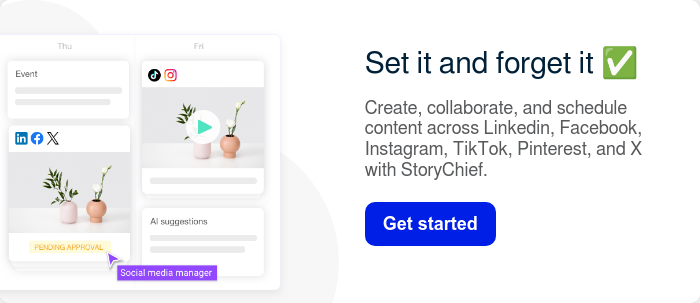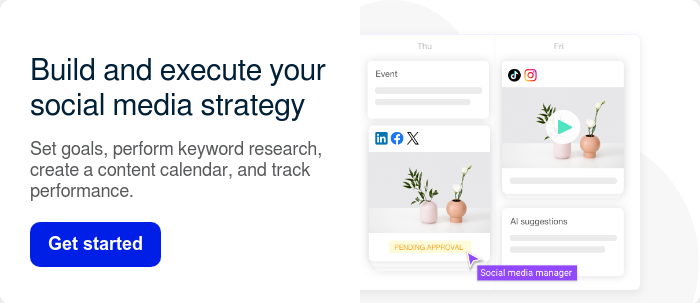Looking for Buffer alternatives in 2026? You're not alone.
Buffer has been a go-to social media scheduling tool for years. But as content strategies become more complex and multichannel, many teams find Buffer too limiting in automation, collaboration, analytics, and integration with full content ops.
In this guide, we’ve handpicked 15 of the best Buffer alternatives — whether you’re a content marketer, social media manager, or agency lead looking for smarter tools to grow your brand.
Let’s dive in.
- StoryChief
- CoSchedule
- Loomly
- Metricool
- SocialBee
- Later
- Planoly
- Sendible
- Sprout Social
- Zoho Social
- ContentStudio
- Publer
- Vista Social
- SocialBu
- Hootsuite
📊 Quick Comparison: Buffer Alternatives 2026
| Tool | Free Plan | AI Features | Best For | Standout Advantage | Main Limitations |
|---|---|---|---|---|---|
| StoryChief | ✅ | ✅ | Multichannel content ops | Blog + social + AI + analytics in one tool | Heavier focus on full content strategy |
| CoSchedule | ✅ | ⚠️ | Editorial teams & content marketing | ReQueue evergreen automation | ReQueue on higher-tier plans |
| Loomly | ✅ | ⚠️ | Brand consistency across socials | History, asset libraries, preview workflow | Can be slow managing large volumes |
| Metricool | ✅ | ⚠️ | Data-driven teams and agencies | Deep analytics + competitor tracking | Content creation features limited |
| SocialBee | ✅ | ✅ | Evergreen content and promo cycles | Tagged recycling with AI content repurposing | UI not as modern |
| Later | ✅ | ⚠️ | Instagram and visual-first brands | Visual calendar, hashtag tools | Not ideal for multi-platform strategy |
| Planoly | ✅ | ⚠️ | E-commerce focused influencers | Product tagging + reel calendar | Limited channel support |
| Sendible | ❌ | ⚠️ | Small to mid-sized agencies | White-label, client dashboards | Higher cost per client/brand |
| Sprout Social | ❌ | ⚠️ | Large teams needing CRM & analytics | Unified inbox + strong listening/reporting | Starts at $249/user/mo |
| Zoho Social | ✅ | ⚠️ | Businesses using Zoho ecosystem | Native CRM + analytics integration | UI quirks, lighter analytics |
| ContentStudio | ✅ | ✅ | AI-powered scheduling & content creation | AI content assistant + discovery | Interface can be sluggish |
| Publer | ✅ | ✅ | Budget-minded creators | AI captioning + Canva integration | Lacks deep analytics |
| Vista Social | ✅ | ✅ | Engagement automation & repurposing | AI repurposing, review monitoring | Feature maturity evolving |
| SocialBu | ✅ | ⚠️ | Solopreneurs & freelancers | AI, curation, recycling & inbox in one UI | Free tier limited; depth varies |
| Hootsuite | ✅ | ⚠️ | Testing across multiple channels | Unified inbox + bulk CSV scheduling | Free tier limited; ads upsold |
- ✅ Free Plan: indicates whether a useful free tier exists.
- ✅ AI Features: highlights built-in AI capabilities (✅) or limited AI tools (⚠️).
📊 Best Buffer Alternatives for Marketing Teams
1. StoryChief (Best for: Multichannel content marketing)
StoryChief lets marketing teams manage their entire content calendar — blog, social, SEO, and campaigns — from a single platform. Unlike Buffer, StoryChief focuses on full content operations.

Top features:
- Drag-and-drop content calendar for blog + social
- AI writing assistant for posts, emails, and captions
- Content approvals, briefs, and workflows
- SEO optimization + multichannel publishing
- Real-time analytics across channels
Why switch from Buffer to alternatives? Buffer is focused purely on social. StoryChief gives you AI-powered multichannel content management in one place.
Use Case: StoryChief’s team builds full monthly calendars in minutes
StoryChief’s content team used their AI agent William to auto-generate a 30-day calendar tailored to their brand. It delivered:
- 20+ post ideas with keywords, personas, dates
- Complete social copy, tailored per channel
- A visual calendar to drag and drop posts
"I love how creative the AI suggestions were. We saved 3+ hours of work."
2. CoSchedule (Best for: Editorial + content-focused teams)
CoSchedule is a powerhouse for marketing teams that need to manage blog content, emails, and social posts all in one place—and its ReQueue feature is a key differentiator over Buffer:

🔧 Key features:
- ReQueue automation: Automatically reshared top-performing or seasonal posts with customizable rules (e.g. #MondayMotivation placeholder groups)
- Full editorial calendar that syncs blog and social schedules.
- Headline Studio: Optimise click-through rates with AI suggestions.
- Built-in Kanban-style task and workflow management.
Why it beats Buffer:
- Buffer handles only basic scheduling; CoSchedule offers full editorial planning with evergreen automation.
Use case:
- A SaaS content team used ReQueue to reshare evergreen blog posts weekly. They now save 6+ hours per week by automating post recycling
Cons:
- ReQueue and advanced collaboration tools are limited to higher-tier plans.
Related: Top 15 CoSchedule Alternatives for Content Marketers and Agencies
3. Loomly (Best for: Brand consistency on social)
Loomly is ideal for teams needing strict branding and approval workflows:

🔧 Key features:
- Real-time previews for each social network.
- Caption optimization tips and recommended posting times.
- Structured approval workflows with comment threads.
- Centralised asset library for consistent creative use.
Why it beats Buffer:
- Buffer has no preview or feedback system—Loomly builds consistency and brand governance into operations.
Use case:
- A global brand uses Loomly to route all regional content through a central approval process, ensuring only on-brand creatives are published.
Cons:
- Performance can slow when handling dozens of brands or high volumes.
4. Metricool (Best for: Deep analytics & competitor tracking)
Metricool offers in-depth analytics and benchmarking that go far beyond what Buffer provides:

🔧 Key features:
- Cross-platform dashboards for social, ads, web & more.
- Real-time competitor benchmarking and hashtag tracking
- Custom, white-label reports with scheduled delivery.
- AI-powered assistance, smart links & approval workflows.
- Integration with design tools like Adobe Express
Why it beats Buffer:
- Buffer delivers only basic engagement stats—Metricool provides multi-dimensional data and competitive insights.
Use case:
- An agency uses Metricool to automate client reporting and monitor competitors—saving hours in Excel every week.
Cons:
- It lacks strong content creation tools compared to other platforms.
5. SocialBee (Best for: Evergreen content republishing)
SocialBee is built to help brands maximize value from evergreen content:

🔧 Key features:
- Category-based scheduling (e.g., promos, blog posts, quotes).
- Evergreen and seasonal content recycling.
- Built-in AI assistant to repurpose posts.
- Link truncation and analytics.
Why it beats Buffer:
- Buffer doesn’t auto-recycle content; SocialBee makes automation of evergreen content easy and robust.
Use case:
- An online course provider uses SocialBee to set up evergreen promo content queues, automatically republishing posts with customized intervals.
Cons:
- The user interface feels dated compared to more modern tools.
6. Later (Best for: Visual-first brands on Instagram & TikTok)
Later is built for visually-driven social platforms, combining an intuitive drag‑and‑drop calendar with AI-powered planning tools

🔧 Key Features
- Visual content calendar with drag‑and‑drop scheduling
- Instagram tools: bulk scheduling, Stories reminders, Linkin.bio landing page
- Media library tagged with notes, filters, and captions
- Hashtag suggestions and best‑time posting insights
- Canva and Unsplash integration
Why it beats Buffer
Offers rich visual planning, deep Instagram features, and media organization buffer lacks.
Use Case
A lifestyle brand used Later to plan Instagram grid aesthetics, scheduling bulk visuals and Stories—saving ~3 hours weekly
Cons
Limited platform support (e.g., TikTok auto-publishing missing), cluttered interface at scale
7. Planoly (Best for: Small creative teams & influencers)
Planoly excels at visually planning posts and handling Instagram product tags.

🔧 Key Features
- Instagram & TikTok grid previews with drag‑and‑drop UI
- Product tagging and analytics for e-commerce
- Visual content calendar with story and reel flexibility
Why it beats Buffer
Provides visual preview and product integration that Buffer doesn't support.
Use Case
An Instagram creator planned cohesive feed layouts with Planoly’s grid view, boosting aesthetic consistency and e-commerce tracking.
Cons
Focuses primarily on Instagram; lacks multi-channel scheduling or analytics.
8. Sendible (Best for: Agencies & client-centered teams)
Sendible is designed for agencies managing multiple brands with client-facing needs.

🔧 Key Features
- Client dashboards, white-labelled access, approval workflows
- Smart post-queueing and calendar previews
- Google Analytics integration, monitoring, competitor tracking
- Post suggestions for content inspiration
Why it beats Buffer
Supports multi-client management with branded reporting and team workflow—a feature Buffer doesn’t provide.
Use Case
A social agency used Sendible to streamline client approvals, deliver white-label reports, and schedule content across 10+ brand calendars.
Cons
Can be expensive for small teams; advanced analytics require higher tiers.
9. Sprout Social (Best for: Enterprise-level teams & CRM)
Sprout Social delivers advanced publishing with social intelligence and reporting.

🔧 Key Features
- Drag-and-drop content calendar and mobile apps
- Unified inbox with social CRM and engagement tools
- Deep analytics, listening, paid ad reporting
Why it beats Buffer
Stronger analytics, engagement, and CRM—key for larger organizations.
Use Case
A corporate brand integrated Sprout Social’s data with customer service CRM, reducing response time by 40%.
Cons
Expensive, with pricing starting at $249/user/mo.
10. Zoho Social (Best for: SMBs in Zoho ecosystem)
Zoho Social is a robust scheduler integrated with the broader Zoho world.

🔧 Key Features
- Unified publishing, scheduling, and monitoring
- Zoho CRM integration and smart listening
- Client publishing and role-based user permissions
Why it beats Buffer
Integrated with Zoho suite—including CRM—and offers smarter collaboration.
Use Case
An SMB combined Zoho Social and CRM to schedule posts while tracking lead data from social campaigns.
Cons
Limited advanced analytics and UI quirks.
11. ContentStudio (Best for: Team collaboration + AI content generation)
ContentStudio is a full-stack solution with built-in AI .

🔧 Key Features
- Content calendar with multi-user permissions
- RSS feed automation and AI post writing
- Analytics dashboard for performance tracking
Why it beats Buffer
Adds AI-driven content generation and smart discovery to routine scheduling.
Use Case
A mid-size team used ContentStudio’s AI assistant to craft captions and automate content suggestions, reducing drafting time by half.
Cons
UI isn't as slick; occasionally slow on load.
12. Publer (Best for: Budget-friendly, AI caption assistant)
Publer offers advanced scheduling with built-in AI tools.

🔧 Key Features
- AI caption and hashtag generator
- Canva integration, bulk uploads, link customization
- Recycling support for evergreen posts and PDFs
Why it beats Buffer
Allows AI captioning and multi-format support with auto link shortening.
Use Case
A solopreneur uses Publer to draft captions automatically and recycle evergreen promotional content every fortnight.
Cons
Lacks depth of publishing analytics and client features.
13. Vista Social (Best for: Engagement automation & AI repurposing)
Vista Social is a rising star with AI-based repurposing and review tracking.


🔧 Key Features
- AI assistant that rewrites long content into post formats
- Review and comment monitoring
- Social CRM functionalities
Why it beats Buffer
Adds AI-driven content conversion and engagement tools.
Use Case
A hotel chain used Vista Social to turn blog outlines into daily social stories and automate guest review monitoring via AI.
Cons
Newer platform; feature stability varies.
14. SocialBu (Best for: Freelancers, solopreneurs, and small teams)
SocialBu has emerged as a powerful all-in-one scheduler—especially appealing for creators and micro-businesses seeking robust features without hefty pricing.
🔧 Key Features:
- Content discovery: Find trending articles for easy reposting.
- Smart scheduling: Auto-repost top content.
- Unified inbox: Manage comments and messages across platforms.
- AI generator: Draft captions using AI for various social media channels.
- Network support: Includes Facebook, Instagram, TikTok, and more.
Why it beats Buffer:
- Supports far more platforms than Buffer’s free plan allows.
- Combines scheduling, curation, AI assistance, and engagement in one interface.
- Includes post recycling and inbox management—features Buffer lacks.
Use Case:
A freelance writer uses SocialBu to:
- Discover new articles with content curation.
- Schedule curated and original content across LinkedIn, Twitter, and X.
- Automatically recycle high-performing posts.
- Respond to audience comments in the unified inbox.
Cons:
The free tier is limited; AI drafting and recycling features require a paid plan. Advanced analytics might not match enterprise-grade tools.
15. Hootsuite (Free Plan) (Best for: Testing before scaling)
Hootsuite’s free tier remains a viable entry-level scheduling tool .

🔧 Key Features
- Limited free scheduling across multiple accounts
- Unified social inbox and basic analytics
- Bulk uploader for CSV-based scheduling
Why it beats Buffer
Free plan supports more networks; better for testing multiple channels.
Use Case
A startup tests social engagement across Facebook, Twitter, and LinkedIn on Hootsuite Free before upgrading to paid options.
Cons
Free version is quite limited; upgrades are costly.
Related: 25 Best Hootsuite Alternatives for Marketers and Agencies
❓ FAQs: Finding the Right Buffer Alternative
What is the best free alternative to Buffer?
Hootsuite Free, and Later Free offer robust free plans covering core scheduling for individuals and small teams, making them excellent Buffer alternatives without a financial commitment.
Which Buffer alternative provides the deepest analytics?
Sprout Social and Metricool stand out for their comprehensive analytics, competitor benchmarking, and reporting – features where Buffer’s reporting is much more basic.
Are there Buffer alternatives with AI-powered post creation?
Yes! Tools like Publer, ContentStudio, Vista Social, and StoryChief offer AI-generated captions, content recycling, and repurposing – functionality not found in Buffer.
Which Buffer alternative is best for Agencies?
Sendible, Sprout Social, and SocialBee excel for agency use with white-label dashboards, multiple-brand support, and client approvals—areas where Buffer’s features are limited.
Which alternative offers visual planning for Instagram?
Later and Planoly provide drag-and-drop grid planning and post previews for Instagram—features that Buffer lacks.
🧠 Final Thoughts: Which Buffer Alternative Is Best for You?
Ready to level up your content publishing with one of these Buffer alternatives?
- All-in-one content ops → Go with StoryChief
- Visual content planning → Later or Planoly for Instagram-first brands
- Agencies & collaborative teams → Sendible, ContentStudio, or Zoho Social
- Analytics-driven → Metricool or Sprout Social
- AI post-generation → ContentStudio, Publer, Vista Social
- Budget-conscious freelancers → Hootsuite Free
➡️ Try StoryChief free today and experience AI-powered social + blog planning like never before.








